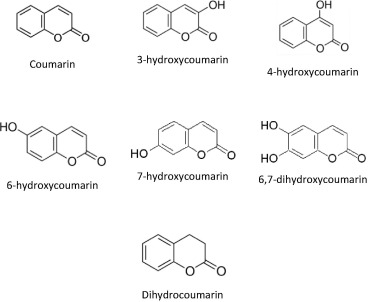식물독 : 쿠마린 Coumarins
독/약 ≫ 천연독 ≫ 식물독 ≫ 식물
식물독 : Coumarins
식물의 종류
- β-Thujone
- Prussic acid
- Hypericin
- Goitrogens
- Furocoumarins
- Pyrrolizidine alkaloids
- Coumarins
- Safrole
- Myristicin

쿠마린은 많은 식물에서 발견되는 물질로 달콤한 냄새가 난다. 쿠마린은 쿠마린을 생성하는 식물에서 살충제로 작용한다. 쿠마린은 간과 신장에 독성을 가지고 있기 때문에 많은 나라에서 음식 첨가제로서의 사용을 금지하고 있다. 임상적으로는 와파린 같은 항응고제 전구체로서 가치가 있다. 인체 발암성 물질로 분류되지 않는다. 흡입시 호흡기의 자극을 유발하고 피부와 눈 접촉시 자극을 유발한다.
(tonka bean, woodruff, clover)
Coumarin (2H-1-benzopyran-2-one) is found in herb teas made from tonka beans (Dipteryx odorata), melilot (Melilotus officinalis or Melilotus arvensis) and woodruff (Asperula odorata), the flavoring oil of bergamot (from Citrus bergamia) and the spice cassia (Cinnamomum cassia; sometimes sold as cinnamon) [91]. Coumarin is liberated from the glycoside melilotoside (an ether of glucose bonded with an ester bond to coumarin) on drying coumarin-containing herb material.
Molds present in spoiled sweet (Melilotus) clover and other hay products can metabolize coumarin to dicoumarol, which is similar in structure to vitamin K [92]. Vitamin K is necessary to activate prothrombin, which is converted to the blood clotting substance thrombin. By inhibiting vitamin K, dicoumarol promotes bleeding. Concentrations of dicoumarol in fodder >10 ppm have been responsible for fatalities by hemorrhaging in cattle [91].
The addition of coumarin to food in the United States was banned in 1954, based on reports of hepatoxicity in rats. However, because a number of foods contain coumarin, humans ingest approximately 0.02 mg coumarin/kg bw/day. The chronic administration of high doses of coumarin causes liver tumors in the rat and liver and lung tumors in the mouse. Overall, available data indicate that coumarin is not genotoxic. It is thought that the carcinogenicity of coumarin is caused by metabolism to toxic epoxides. Because doses of coumarin that cause toxicity and carcinogenicity in the lung and liver of experimental animals are more than 100 times the maximum human intake, exposure to coumarin from food poses no health risk to humans [93].
The addition of coumarin is prohibited in 21 CFR 189.130. The regulation notes that coumarin is found in tonka beans and extract of tonka beans, among other natural sources, and is also synthesized. It has been used as a flavoring compound, therefore addressing not just natural products (which would include buffalo grass or sweetgrass (Hierochloe odorata) used in flavoring vodka and other natural sources (see above)), as well as synthesized coumarin. Further, according to the regulation, “(b) Food containing any added coumarin as such or as a constituent of tonka beans or tonka extract is deemed to be adulterated under the act, based upon an order published in the Federal Register of March 5, 1954 (19 Federal Register 1239).” An analytical method for detection of coumarin in foods is specified in 21 CFR 189.130.
|
|
Network ≫ 두뇌, 마음, 욕구
뇌의 작동원리, 지도원리
감각 기관
보상시스템
- 학습 파페츠
- 목적 동기 부여 회로
식욕 mechanism
- Food Pleasure
file.txt
file.txt
|